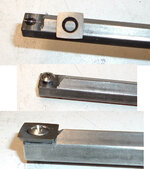Dale Allen
Member
Can any of you machinists recommend a good brand and type of thread tap?
I am trying to tap 6-32 through holes in 1018 and 12L14 steel. The 1018 is 1/2" thick and the 12L14 is 3/8". The taps are through-hole type.
I had a $6 HSS tap from McMaster that broke about half way through the process. I then went to the local hardware and wasted $4 on a Hanson that broke just as quick. I am using a #36 cobalt steel bit and the steel is drilled out fine. That bit is supposed to be a 75% thread cut.
I can drill and tap 8-32 holes without much trouble. However, I noticed that the Hanson 8-32 tap that has done about 4 holes has nicks in the lower taper threads and I am sure that is making it more difficult than it should be.
Seems to me that taking these to a machine shop would cost more than a $22 cobalt steel tap.
Any suggestions are much appreciated.
Dale
I am trying to tap 6-32 through holes in 1018 and 12L14 steel. The 1018 is 1/2" thick and the 12L14 is 3/8". The taps are through-hole type.
I had a $6 HSS tap from McMaster that broke about half way through the process. I then went to the local hardware and wasted $4 on a Hanson that broke just as quick. I am using a #36 cobalt steel bit and the steel is drilled out fine. That bit is supposed to be a 75% thread cut.
I can drill and tap 8-32 holes without much trouble. However, I noticed that the Hanson 8-32 tap that has done about 4 holes has nicks in the lower taper threads and I am sure that is making it more difficult than it should be.
Seems to me that taking these to a machine shop would cost more than a $22 cobalt steel tap.
Any suggestions are much appreciated.
Dale

